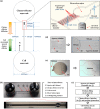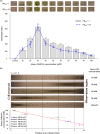Quantitative analysis of the chemotaxis of a green alga, Chlamydomonas reinhardtii, to bicarbonate using diffusion-based microfluidic device
- PMID: 26958101
- PMCID: PMC4769253
- DOI: 10.1063/1.4942756
Quantitative analysis of the chemotaxis of a green alga, Chlamydomonas reinhardtii, to bicarbonate using diffusion-based microfluidic device
Abstract
There is a growing interest in the photosynthetic carbon fixation by microalgae for the production of valuable products from carbon dioxide (CO2). Microalgae are capable of transporting bicarbonate (HCO3 (-)), the most abundant form of inorganic carbon species in the water, as a source of CO2 for photosynthesis. Despite the importance of HCO3 (-) as the carbon source, little is known about the chemotactic response of microalgae to HCO3 (-). Here, we showed the chemotaxis of a model alga, Chlamydomonas reinhardtii, towards HCO3 (-) using an agarose gel-based microfluidic device with a flow-free and stable chemical gradient during the entire assay period. The device was validated by analyzing the chemotactic responses of C. reinhardtii to the previously known chemoattractants (NH4Cl and CoCl2) and chemotactically neutral molecule (NaCl). We found that C. reinhardtii exhibited the strongest chemotactic response to bicarbonate at the concentration of 26 mM in a microfluidic device. The chemotactic response to bicarbonate showed a circadian rhythm with a peak during the dark period and a valley during the light period. We also observed the changes in the chemotaxis to bicarbonate by an inhibitor of bicarbonate transporters and a mutation in CIA5, a transcriptional regulator of carbon concentrating mechanism, indicating the relationship between chemotaxis to bicarbonate and inorganic carbon metabolism in C. reinhardtii. To the best of our knowledge, this is the first report of the chemotaxis of C. reinhardtii towards HCO3 (-), which contributes to the understanding of the physiological role of the chemotaxis to bicarbonate and its relevance to inorganic carbon utilization.
Figures






References
-
- Borowitzka M. A., J. Appl. Phycol. 25, 743 (2013).10.1007/s10811-013-9983-9 - DOI
LinkOut - more resources
Full Text Sources
Other Literature Sources
